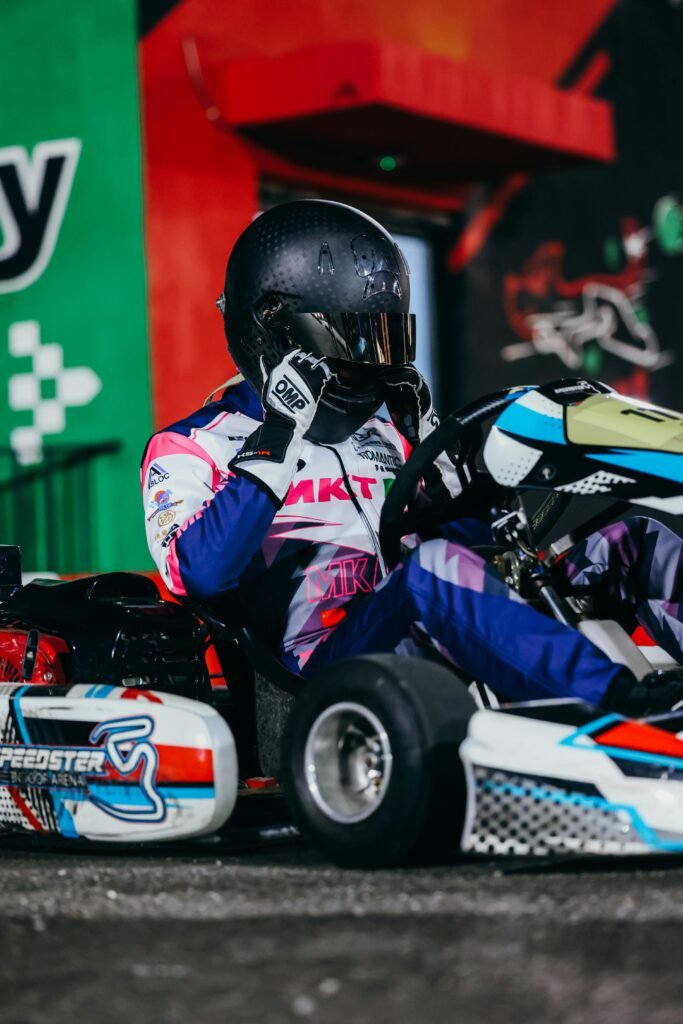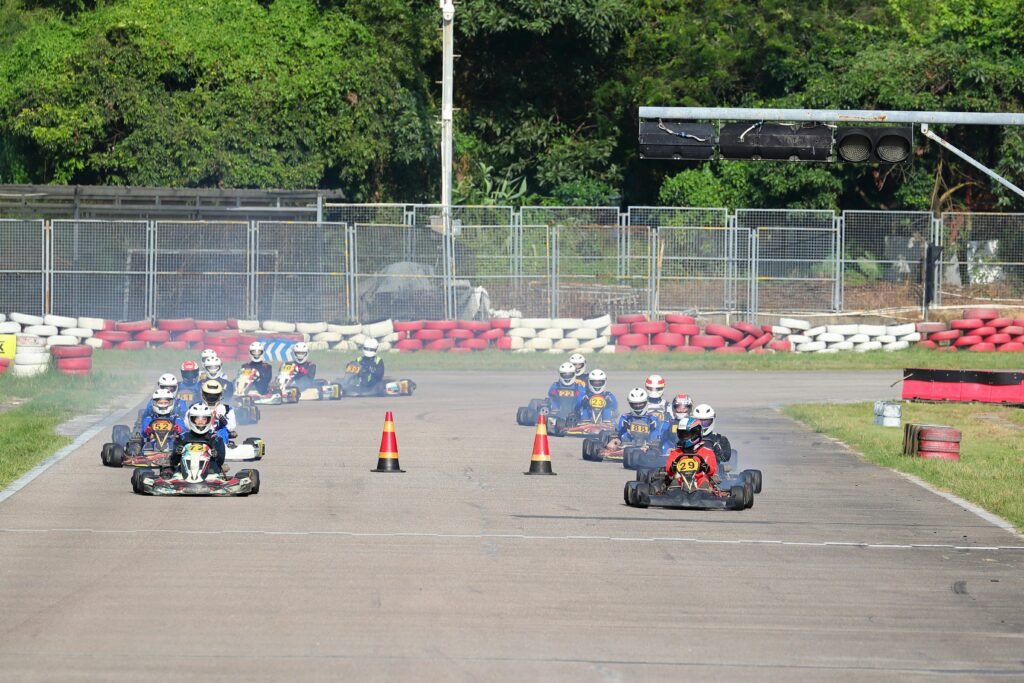Go-karting is a sport that balances thrills with safety, thanks to the well-engineered karts, protective gear, and regulated track environments. It is considered a safe activity, especially when the appropriate safety measures are in place and followed. However, like any motorsport, safety is paramount, and adhering to guidelines is essential to ensure a fun and secure experience.
Here’s a detailed look at why go-karting is safe and how to further minimize risks:

1. Safety Gear and Equipment
Tracks and karting academies take safety very seriously, and they provide protective gear to ensure the driver’s well-being in case of any accidents.
- Helmets: Every driver must wear a helmet that meets safety standards. This protects the head from any potential impacts in the event of a collision or rollover.
- Gloves and racing suits: Gloves provide better grip on the steering wheel, while racing suits offer protection from scrapes or minor burns from friction.
- Neck braces (optional): Some tracks provide neck braces to prevent whiplash, particularly useful for high-speed or competitive karting.
- Closed-toe shoes: Wearing proper footwear, such as closed-toe shoes or karting-specific shoes, ensures proper control over the pedals.
Pro Tip: Always ensure that your safety gear fits properly. A helmet that’s too loose or a racing suit that’s too tight can compromise safety.

2. Kart Design and Safety Features
Go-karts are designed with built-in safety features to protect drivers, even in the case of accidents. Some of the most common safety features include:
- Seat belts and roll bars: Many karts come equipped with seat belts to keep drivers securely in their seats and roll bars to protect them in case of a rollover.
- Low center of gravity: Karts are built with a low center of gravity, making it difficult for them to flip over even during sharp cornering or minor collisions.
- Durable chassis: The frame of a kart is designed to withstand minor collisions, absorbing impact and preventing damage to the driver.
- Speed limiters (for beginners): Some tracks use speed-limited karts for younger or less experienced drivers, ensuring that the speed stays within safe limits.
Key Takeaway: Karts are built with safety in mind, ensuring that drivers are protected while experiencing the thrill of racing.
3. Track Safety Measures
Professional go-kart tracks are designed to prioritize the safety of all participants. They incorporate several important features that help minimize the risks associated with the sport:
- Barrier systems: Tracks are often lined with safety barriers made of tires, plastic, or foam, designed to absorb the impact of a collision and protect drivers from hitting hard surfaces.
- Track layout: Many tracks have smooth, well-maintained surfaces to prevent unexpected bumps or obstacles. The layout also encourages safe driving lines, with clear demarcations for braking and overtaking zones.
- Flagging system: Tracks use flag signals to communicate important information to drivers. For example:
- Yellow flag: Caution, slow down.
- Red flag: Stop the race.
- Blue flag: Allow faster drivers to overtake.
- Trained staff and marshals: Tracks are monitored by marshals who enforce safety rules, provide guidance, and intervene when necessary to prevent accidents.
Key Takeaway: Properly designed tracks and vigilant marshals ensure that safety is maintained throughout the karting session.

4. Enforced Safety Rules and Guidelines
To keep go-karting safe, strict rules are enforced at all professional tracks. These rules help prevent reckless driving and ensure that all participants understand the importance of safety:
- Pre-race briefings: Before starting a race or session, drivers receive safety briefings on track rules, how to handle karts, and what to do in case of emergencies.
- Speed restrictions: For novice drivers or children, many tracks limit kart speeds to make the experience safer and more controlled.
- Driver conduct: Aggressive or dangerous driving is usually met with penalties or disqualification, ensuring that drivers respect each other on the track and follow the rules.
Pro Tip: Take pre-race briefings seriously and always follow the track’s rules to avoid accidents or penalties.
5. Regular Kart Maintenance
Professional go-kart tracks are responsible for the maintenance of the karts they provide. Ensuring the vehicles are well-maintained reduces the risk of mechanical failures that could lead to accidents. Regular checks are conducted to:
- Inspect tires: Making sure the tires have the right pressure and are not overly worn, providing proper grip and handling.
- Check brakes: Well-maintained brakes are essential for safe stopping, especially at high speeds.
- Ensure engine performance: Engines are tuned and inspected for safe operation, minimizing the risk of sudden breakdowns during a race.
Key Takeaway: Regular kart maintenance is essential to ensure that each vehicle is safe and performs reliably on the track.
6. Inherent Risks in Motorsports

While go-karting is generally safe, like all motorsports, it carries some inherent risks, such as:
- Collisions with other karts: If drivers don’t follow the rules or are overly aggressive, there’s a chance of colliding with other karts.
- Spins or loss of control: Novice drivers may overestimate their abilities, leading to spins or loss of control, especially in sharp corners or wet conditions.
- Minor injuries: Even with safety measures in place, small accidents may result in minor injuries like scrapes, bruises, or sore muscles.
7. How to Minimize Risk
Here’s how you can reduce your chances of accidents and injuries during go-karting:
- Drive within your limits: Don’t push the kart beyond your skill level, especially if you’re a beginner.
- Follow the racing line: Sticking to the racing line and following proper braking and cornering techniques will reduce the risk of losing control.
- Avoid aggressive behavior: Don’t ram into other karts or take unnecessary risks while overtaking.
- Stay aware of your surroundings: Always be mindful of what’s happening around you, and be ready to react if another driver makes a mistake.
Key Takeaway: Respect the safety guidelines and drive responsibly to minimize risks and enjoy a safe karting experience.
Go-Karting is Safe with Proper Precautions
Go-karting is generally considered a safe activity, particularly at professional tracks where safety measures are enforced. With protective gear, well-designed karts, and well-maintained tracks, the sport offers a thrilling yet safe experience. However, as with any motorsport, it’s crucial to follow safety guidelines, respect track rules, and drive within your abilities to minimize risks.
With the right safety measures in place, you can enjoy an exhilarating and safe go-karting experience!
